
OUR VOLUNTEERS
02/07/20 — Ada Broussard
The JBG Community has many facets. It includes our employees and their families, of course, our CSA Members, our market customers (their dogs), and our restaurant partners. Yet there is one more facet of our community that is perhaps more jovial, more selfless, and more diverse than the rest: our volunteers.
![]() Volunteers at Hergotz helping to put together roasting bags for the farmers' markets. Have you ever seen a more colorful table? Photo by Scott David Gordon.
Volunteers at Hergotz helping to put together roasting bags for the farmers' markets. Have you ever seen a more colorful table? Photo by Scott David Gordon.
Since JBG’s Holly Street days (when our farm was a garden, our fields a backyard) volunteers have been an integral part of the story. In the “old days”, volunteers used to actually pack CSA boxes! Volunteers' hardworking hands have helped save thousands of pounds of root crops from damaging freezes and seed over a million vegetables - each tiny seed going into an individual cell tray, sometimes picked up one by one and sometimes rolled around in our nifty vacuum seeder. Not only could we not do it without our volunteers, we simply wouldn’t want to. Farming can be tough, and on the hardest of days, when the bins of carrots just don’t seem to end, our tribe of volunteers are a welcome addition to the barn and greenhouse. A volunteer’s genuine enthusiasm for the vibrancy of our watermelon radishes or the smell of our dill help remind even the grumpiest of farmers that what we’re doing is, in fact, neat. And apart from the general cheerleading-affect that our volunteers have on our operation, they’re also just wonderful people to be around. The makeup of our volunteers is as diverse as the vegetables we grow. There are the college students, the musicians, and the artists. There are those who visit us in between jobs when they find themselves with the gift of free time. There are the retirees and the flocks of teachers who descend in the summer, the hippies and the corporate team-builds. We love them all, and if you’re a volunteer reading this - thank you! You are an integral piece in the puzzle that is our local food system, and your hard work truly does help get fresh and nutritious vegetables from the JBG fields into our collective community. And if you’ve never volunteered with the farm before, we thought we’d take a quick moment to tell you about the program.
For most folks, the most exciting part of volunteering at JBG is the fact that after a day of volunteering, we’ll send you home with a giant bushel of veggies. We sometime hose corporate team builds (is this you??) and in these instances some groups decide to take their veggies home and some donate the fresh produce to local soup kitchens. If you come to volunteer at JBG, you'll choose between two locations: Hergotz or Garfield. Whichever you choose, any good volunteer should leave with a bit of dirt under her fingernails, mud on her shoes, and a great big smile.
Volunteers at Hergotz help with all of the post-harvest processing of our vegetables, including the sorting and packing of produce for farmers’ markets and our CSA boxes. Volunteers at Hergotz should expect to stand the whole time and to work outside under a covered pavilion. Hergotz volunteers should expect to spend some time getting to know our carrots. Purple carrots! White carrots! Beautiful carrots! Carrots that hopefully have a great personality! Leg carrots! Volunteer at Hergotz and you’ll likely have a very funny carrot riding home on your dashboard. Though the majority of our need for volunteers at Hergotz is M-F, we occasionally need help on Saturdays welcoming home our weary market staff and helping them break down their trucks.
Our post-volunteering recommendations involve a field trip to Callahan’s (make sure you see the baby animals) or a beer at one of two nearby breweries: Live Oak or Hi Sign.
![]() Did someone say carrots? Photo by Scott David Gordon
Did someone say carrots? Photo by Scott David Gordon
Garfield volunteers can expect to help our Greenhouse Manager, Giana, in day to day greenhouse tasks including soil mixing, filling of flats, planting of seeds, and getting plants staged and ready to go for placement in the fields. If you’d prefer a volunteer shift that is predominantly seated, shoot us an email to see if there is a lot of seeding to be done; this job is usually done seated at a table, overlooking our perennial herb beds, with some faint Austin radio playing in the background. If it sounds dreamy, it is!
After a day on the farm, we recommend you swing by our favorite Thai restaurant in town, which happens to be located in Garfield: Little Thailand!
![]()
![]() Last year's greenhouse sale - so many happy gardeners! Photo by Scott David Gordon.
Last year's greenhouse sale - so many happy gardeners! Photo by Scott David Gordon.
![]()
![]() Angie, left, and some of our amazing volunteers. Photo by Scott David Gordon.
Angie, left, and some of our amazing volunteers. Photo by Scott David Gordon.
We asked our Hergotz Volunteer Coordinator, Angie, why folks should come volunteer with us and she responded, “They should consider volunteering with us because it is fun! They get loads of veggies and an inside look at how those veggies get to market. They will meet other people who are almost guaranteed to have similar interests….You get five dedicated hours to get to know interesting people.” Over the past 7 years we’ve had a wonderful lineage of folks leading the Volunteer Program: Marty, Andrew, Sarah, Ciara, Nicki… Angie joins the ranks of these wonderful JBGers, and even though she suggests you should volunteer to get to know other volunteers, we think you should volunteer to get to know Angie! And of course, come for the veggies and crazy carrots, too.
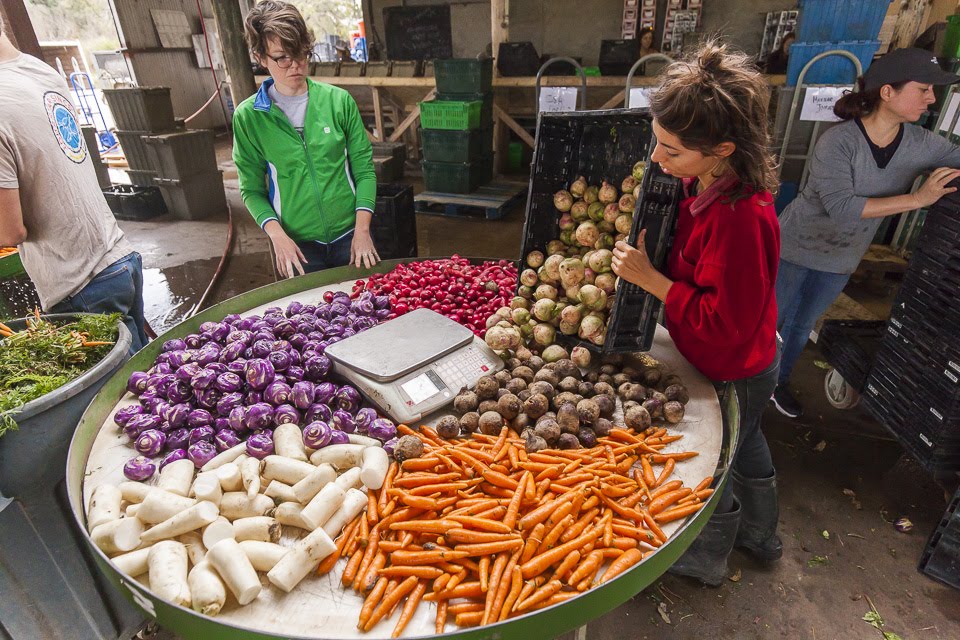 Volunteers at Hergotz helping to put together roasting bags for the farmers' markets. Have you ever seen a more colorful table? Photo by Scott David Gordon.
Volunteers at Hergotz helping to put together roasting bags for the farmers' markets. Have you ever seen a more colorful table? Photo by Scott David Gordon.
Since JBG’s Holly Street days (when our farm was a garden, our fields a backyard) volunteers have been an integral part of the story. In the “old days”, volunteers used to actually pack CSA boxes! Volunteers' hardworking hands have helped save thousands of pounds of root crops from damaging freezes and seed over a million vegetables - each tiny seed going into an individual cell tray, sometimes picked up one by one and sometimes rolled around in our nifty vacuum seeder. Not only could we not do it without our volunteers, we simply wouldn’t want to. Farming can be tough, and on the hardest of days, when the bins of carrots just don’t seem to end, our tribe of volunteers are a welcome addition to the barn and greenhouse. A volunteer’s genuine enthusiasm for the vibrancy of our watermelon radishes or the smell of our dill help remind even the grumpiest of farmers that what we’re doing is, in fact, neat. And apart from the general cheerleading-affect that our volunteers have on our operation, they’re also just wonderful people to be around. The makeup of our volunteers is as diverse as the vegetables we grow. There are the college students, the musicians, and the artists. There are those who visit us in between jobs when they find themselves with the gift of free time. There are the retirees and the flocks of teachers who descend in the summer, the hippies and the corporate team-builds. We love them all, and if you’re a volunteer reading this - thank you! You are an integral piece in the puzzle that is our local food system, and your hard work truly does help get fresh and nutritious vegetables from the JBG fields into our collective community. And if you’ve never volunteered with the farm before, we thought we’d take a quick moment to tell you about the program.
For most folks, the most exciting part of volunteering at JBG is the fact that after a day of volunteering, we’ll send you home with a giant bushel of veggies. We sometime hose corporate team builds (is this you??) and in these instances some groups decide to take their veggies home and some donate the fresh produce to local soup kitchens. If you come to volunteer at JBG, you'll choose between two locations: Hergotz or Garfield. Whichever you choose, any good volunteer should leave with a bit of dirt under her fingernails, mud on her shoes, and a great big smile.
Hergotz Packing Shed: Monday-Friday, 8am-1pm
Okay, technically, if you come on a Monday we get started a little later… everyone needs to ease into the week. Our Hergotz Packing shed is located at 9515 Hergotz Lane and is just near the airport, behind Callahan’s General Store.Volunteers at Hergotz help with all of the post-harvest processing of our vegetables, including the sorting and packing of produce for farmers’ markets and our CSA boxes. Volunteers at Hergotz should expect to stand the whole time and to work outside under a covered pavilion. Hergotz volunteers should expect to spend some time getting to know our carrots. Purple carrots! White carrots! Beautiful carrots! Carrots that hopefully have a great personality! Leg carrots! Volunteer at Hergotz and you’ll likely have a very funny carrot riding home on your dashboard. Though the majority of our need for volunteers at Hergotz is M-F, we occasionally need help on Saturdays welcoming home our weary market staff and helping them break down their trucks.
Our post-volunteering recommendations involve a field trip to Callahan’s (make sure you see the baby animals) or a beer at one of two nearby breweries: Live Oak or Hi Sign.
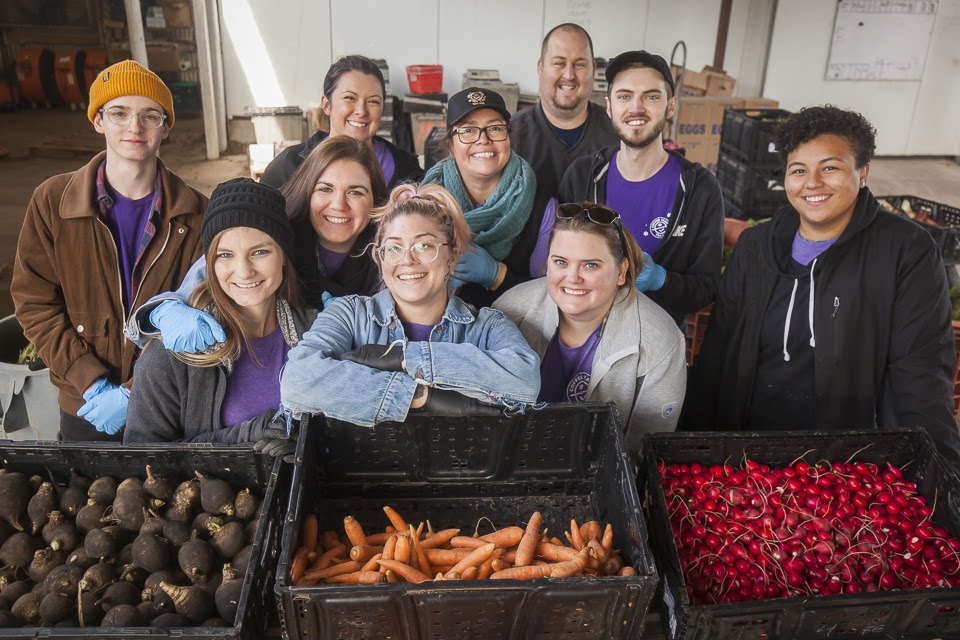 Did someone say carrots? Photo by Scott David Gordon
Did someone say carrots? Photo by Scott David Gordon
Garfield Farm Greenhouse Volunteering: Monday-Friday 8:30am-1pm
If you’re eager to get outside and experience ground zero of our local food system, plan to volunteer a day in our greenhouse. The address to our “Big Farm” where this volunteer shift is located is 4008 River Road, Garfield Texas. Look for the Garfield water tower, then go a bit further. (If you pass the gigantic Squirrel at Berdoll’s Pecan shop you’ve gone too far…).Garfield volunteers can expect to help our Greenhouse Manager, Giana, in day to day greenhouse tasks including soil mixing, filling of flats, planting of seeds, and getting plants staged and ready to go for placement in the fields. If you’d prefer a volunteer shift that is predominantly seated, shoot us an email to see if there is a lot of seeding to be done; this job is usually done seated at a table, overlooking our perennial herb beds, with some faint Austin radio playing in the background. If it sounds dreamy, it is!
After a day on the farm, we recommend you swing by our favorite Thai restaurant in town, which happens to be located in Garfield: Little Thailand!
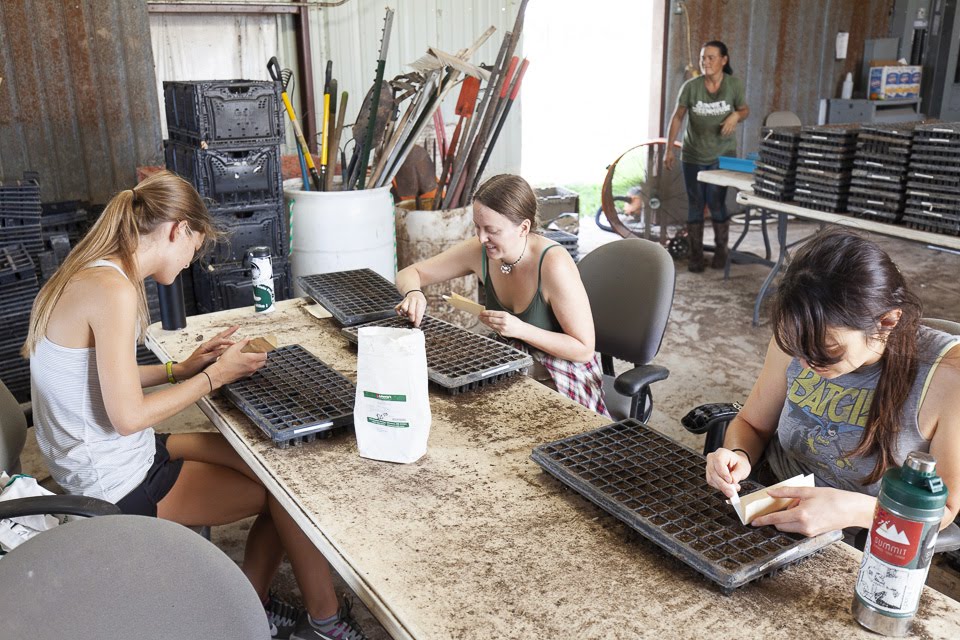
Transplant Sale Volunteers: A Saturday Opportunity for all you 9-5ers!
We know that our weekday volunteer slots are prohibitive from many of you, and so we’re happy to announce that we have several Saturday volunteers opportunities coming up at our Annual Transplant Sale! On Saturday February 29th, March 7th, March 14, and March 21st we are looking for several volunteers to help us at our transplant sale, happening at our Garfield Greenhouses. The perfect activity to satiate your spring fever! Volunteers for these Saturdays will be given the option to take home a CSA box or some transplants as a thank you for their time. If you’re interested in planting a spring garden but don’t know where to start, come volunteer with us! You’ll have all day to choose your transplants and pick our farmers’ brains on how to grow your best garden yet. If you want to signup to volunteer at this sale, please email Angie directly with “Transplant Sale Volunteer” in the subject line - volunteer@jbgorganic.com .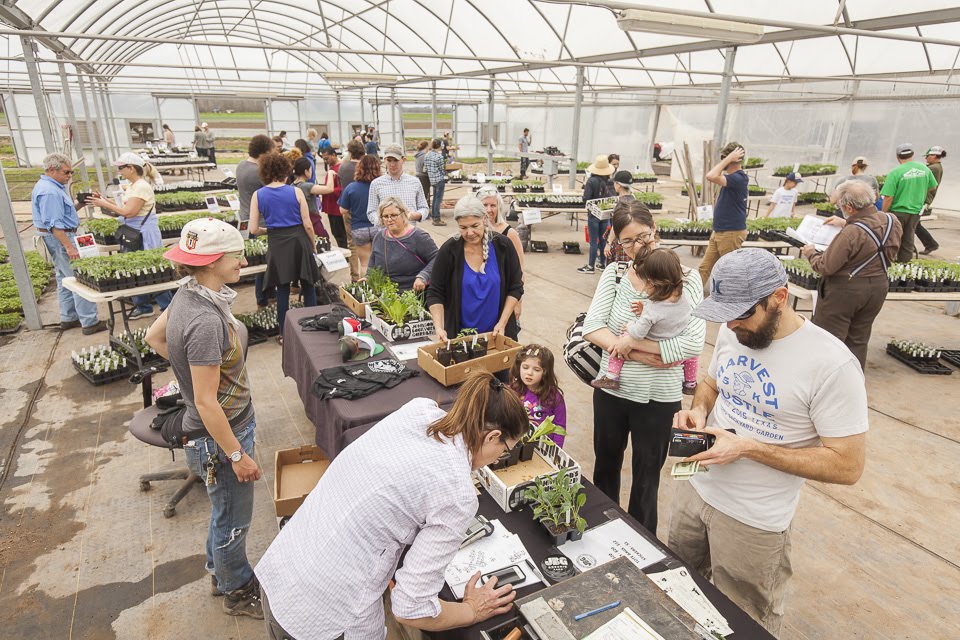 Last year's greenhouse sale - so many happy gardeners! Photo by Scott David Gordon.
Last year's greenhouse sale - so many happy gardeners! Photo by Scott David Gordon.
How to Volunteer:
It’s easy. Just fill out this Google Form and our Volunteer Coordinator Angie will confirm your volunteer shift. If you have any questions about volunteering or perhaps just need a purple top turnip recipe, don’t hesitate to reach out. If you’d like to volunteer for the Transplant Sale, skip the Google Form and just email Angie directly - volunteer@jbgorganic.com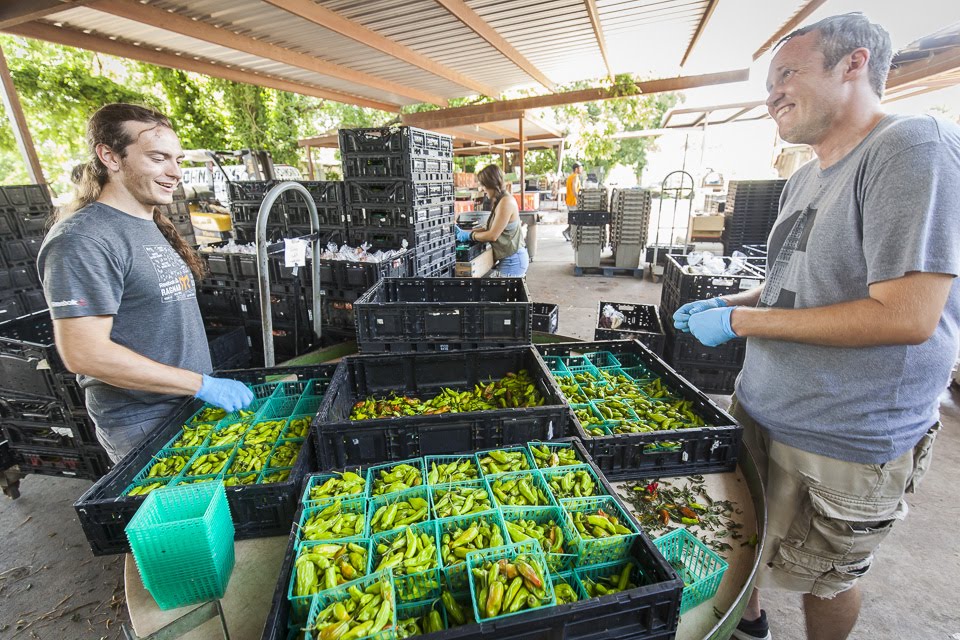
Scheduled to Volunteer?
Please come dressed in closed you don’t mind getting dirty or wet and wear closed toed shoes. There are lots of hazards for open toes! If it’s cold, dress like an onion - in lots of layers. If it’s hot and you’re wearing a sleeveless top, we recommended you bring sun screen. Hats, water bottles, and a light snack are never a bad idea. Ever!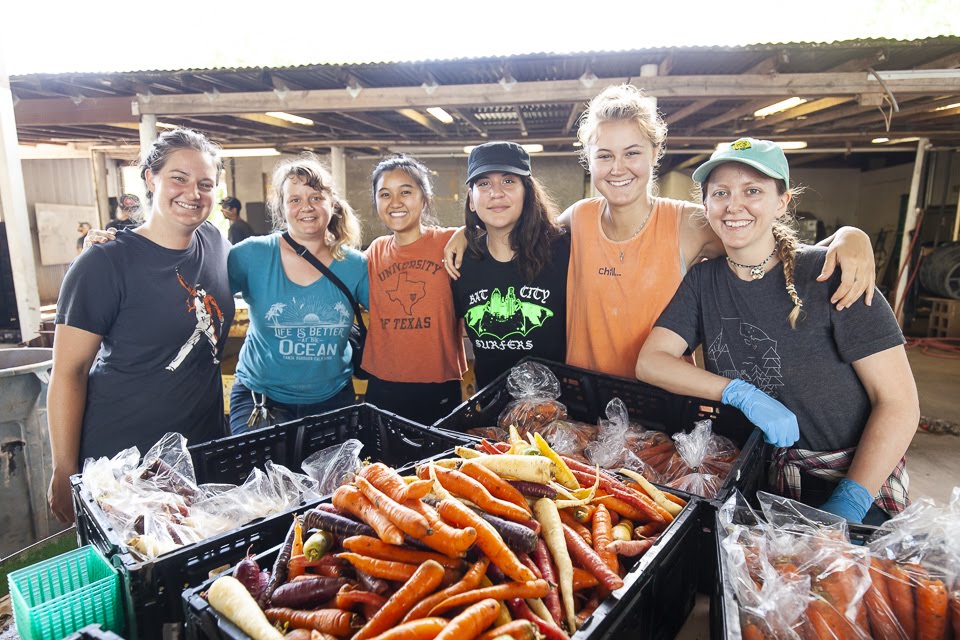 Angie, left, and some of our amazing volunteers. Photo by Scott David Gordon.
Angie, left, and some of our amazing volunteers. Photo by Scott David Gordon.
We asked our Hergotz Volunteer Coordinator, Angie, why folks should come volunteer with us and she responded, “They should consider volunteering with us because it is fun! They get loads of veggies and an inside look at how those veggies get to market. They will meet other people who are almost guaranteed to have similar interests….You get five dedicated hours to get to know interesting people.” Over the past 7 years we’ve had a wonderful lineage of folks leading the Volunteer Program: Marty, Andrew, Sarah, Ciara, Nicki… Angie joins the ranks of these wonderful JBGers, and even though she suggests you should volunteer to get to know other volunteers, we think you should volunteer to get to know Angie! And of course, come for the veggies and crazy carrots, too.
RADISH SALAD
02/05/20 — Ada Broussard
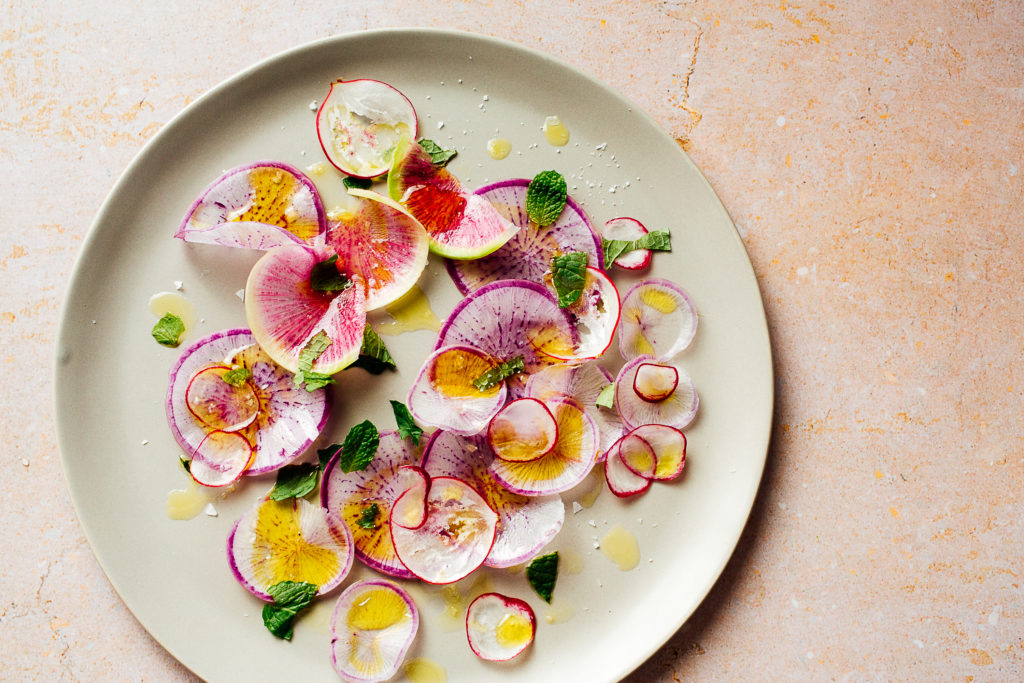 Over the holidays, Ada Broussard served a beautiful salad featuring 4 or 5 different kinds of thinly sliced radishes, a smattering of herbs, olive oil, lemon juice and flaky sea salt. This is an ode to Ada’s salad, with a fun tip: giving radishes 5-10 minute bath in ice water will cause them to ruffle up so they get extra crunchy. I use the radishes-in-ice-bath trick any time am eating thinly sliced radishes (hello tacos, posole!), ice in the freezer and a few extra minutes to spare. Dry cold crunchy radishes on a towel before serving.
Over the holidays, Ada Broussard served a beautiful salad featuring 4 or 5 different kinds of thinly sliced radishes, a smattering of herbs, olive oil, lemon juice and flaky sea salt. This is an ode to Ada’s salad, with a fun tip: giving radishes 5-10 minute bath in ice water will cause them to ruffle up so they get extra crunchy. I use the radishes-in-ice-bath trick any time am eating thinly sliced radishes (hello tacos, posole!), ice in the freezer and a few extra minutes to spare. Dry cold crunchy radishes on a towel before serving.
I think Ada would agree with me, that the key to a show-stopping radish salad is a selection of as many types of radishes as you can find. The one in the picture features purple daikon radishes, watermelon radishes, and plain ol’ red radishes that may or may not go by another name. French breakfast radishes would also be tasty and beautiful here.
As far as how to dress your multi-radish salad, opt for a high-quality olive oil and flaky salt, then use whatever you have on hand for the finishing touches. Acid in the form of citrus, vinegar or pickle juice all work well, and mint is my favorite herb to balance the spice of the radish, but other soft herbs like parsley, cilantro, dill or tarragon are also excellent here. And hey, a drizzle of honey never hurt anyone! Use what you have and don’t think twice. Make a point to take in the intricate beauty will find when you stare into the cross section of each slice of radish. Nature is a trip!
Photos by Mackenzie Smith Kelley
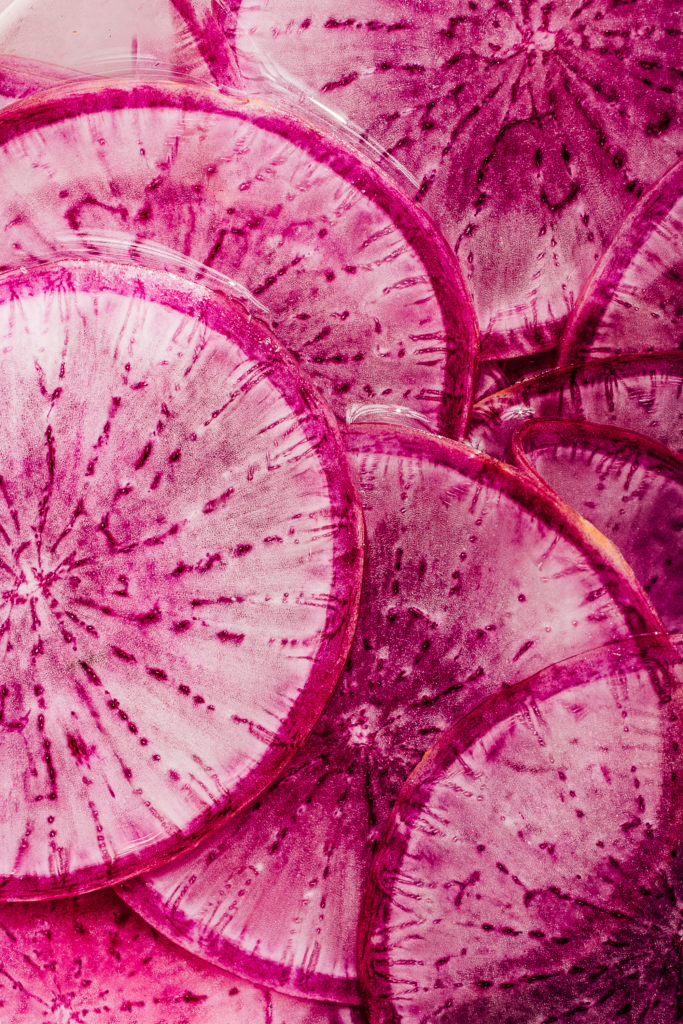
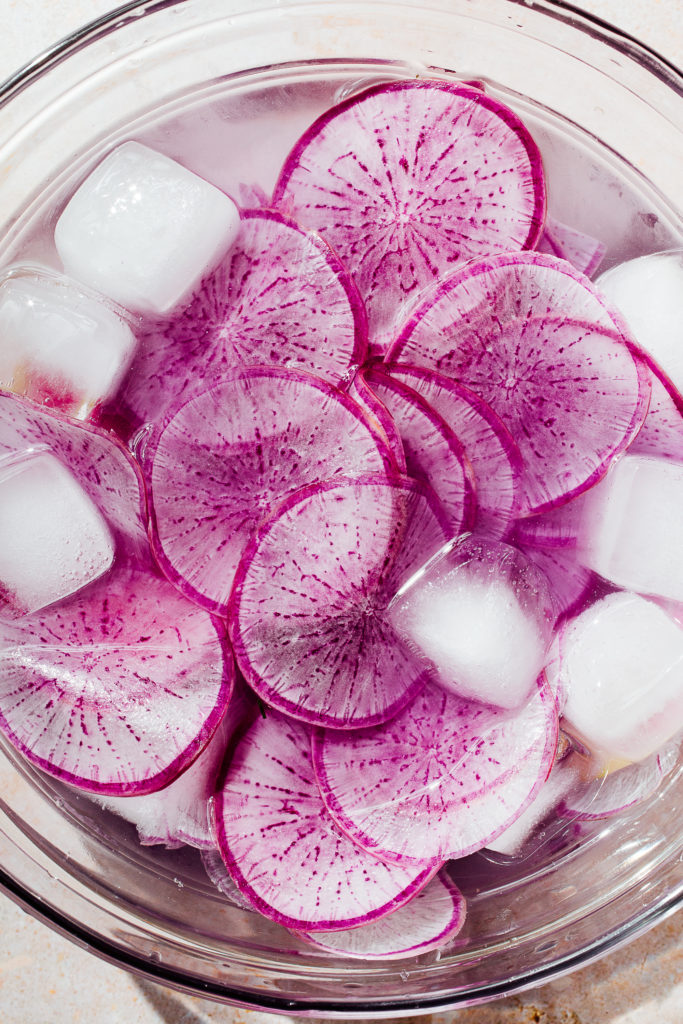
CSA BOX CONTENTS WEEK OF FEB 3RD
02/04/20 — Scott
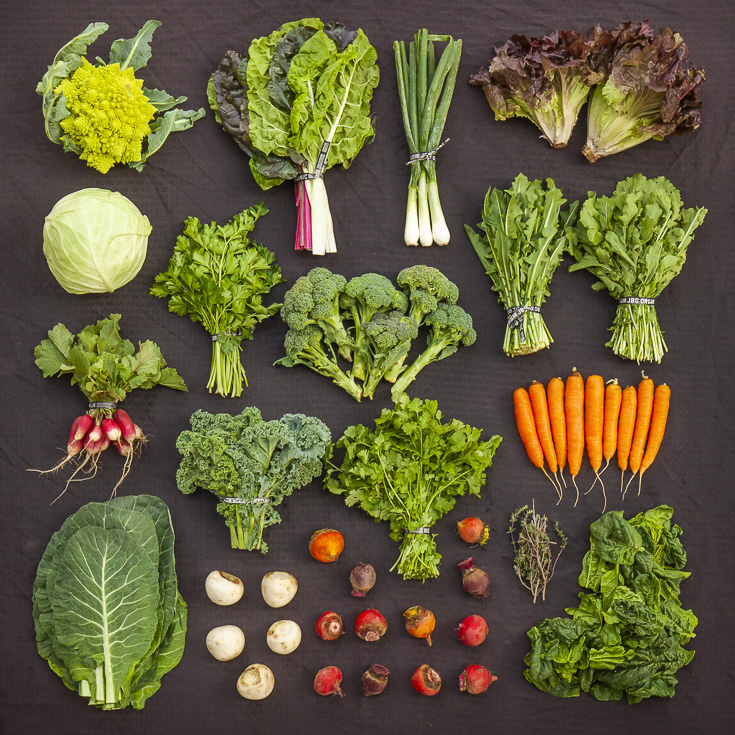 CSA Box Contents Week of Feb 3rd
CSA Box Contents Week of Feb 3rd
Large Box
Beets
Broccoli
Cabbage, Red
Carrot, Orange
Cauliflower
Greens, Chard, Rainbow
Greens, Spinach
Herb, Cilantro
Lettuce, Romaine
Onion, Spring White
Radish, French Breakfast
Turnip, Rutabaga
Beets
Broccoli
Cabbage, Red
Carrot, Orange
Cauliflower
Greens, Chard, Rainbow
Greens, Spinach
Herb, Cilantro
Lettuce, Romaine
Onion, Spring White
Radish, French Breakfast
Turnip, Rutabaga
Medium Box
Beets
Cabbage
Carrot, Orange
Cauliflower
Greens, Kale, Curly
Greens, Spinach
Lettuce, Romaine
Onion, Spring White
Radish, French Breakfast
Turnip, Rutabaga
Beets
Cabbage
Carrot, Orange
Cauliflower
Greens, Kale, Curly
Greens, Spinach
Lettuce, Romaine
Onion, Spring White
Radish, French Breakfast
Turnip, Rutabaga
Small Box
Beets
Cabbage
Greens, Chard, Rainbow
Greens, Spinach
Lettuce, Romaine
Onion, Spring White
Radish, French Breakfast
Beets
Cabbage
Greens, Chard, Rainbow
Greens, Spinach
Lettuce, Romaine
Onion, Spring White
Radish, French Breakfast
Individual Box
Beets
Cabbage
Greens, Kale, Curly
Lettuce, Romaine
Onion, Spring White
Beets
Cabbage
Greens, Kale, Curly
Lettuce, Romaine
Onion, Spring White
PHOTOS FROM THE FARM: 1.31.2020
01/31/20 — Ada Broussard
It's hard to believe the first month of 2020 is coming to a close. But, if you read this week's blog post, you'll know that there's really no time to be sentimental. Thanks to our amazing farm photographer, Scott David Gordon, for capturing this week's happenings so well.
![]() Carrots that make you want to go bunny. Photo by Scott David Gordon.
Carrots that make you want to go bunny. Photo by Scott David Gordon.
![]() Cleaning up our green onions is wet work. Photo by Scott David Gordon.
Cleaning up our green onions is wet work. Photo by Scott David Gordon.
![]() Luke calculating and documenting his fertigation plan for the onions. Photo by Scott David Gordon.
Luke calculating and documenting his fertigation plan for the onions. Photo by Scott David Gordon.
![]() We still have a couple onions to plant.... Photo by Scott David Gordon.
We still have a couple onions to plant.... Photo by Scott David Gordon.
![]() Spinach for the people. Photo by Scott David Gordon.
Spinach for the people. Photo by Scott David Gordon.
![]() Greenhouse etiquette 101: Don't forget to close the door! Photo by Scott David Gordon.
Greenhouse etiquette 101: Don't forget to close the door! Photo by Scott David Gordon.
![]() Welcome back, beets. It's great to see ya! Photo by Scott David Gordon.
Welcome back, beets. It's great to see ya! Photo by Scott David Gordon.
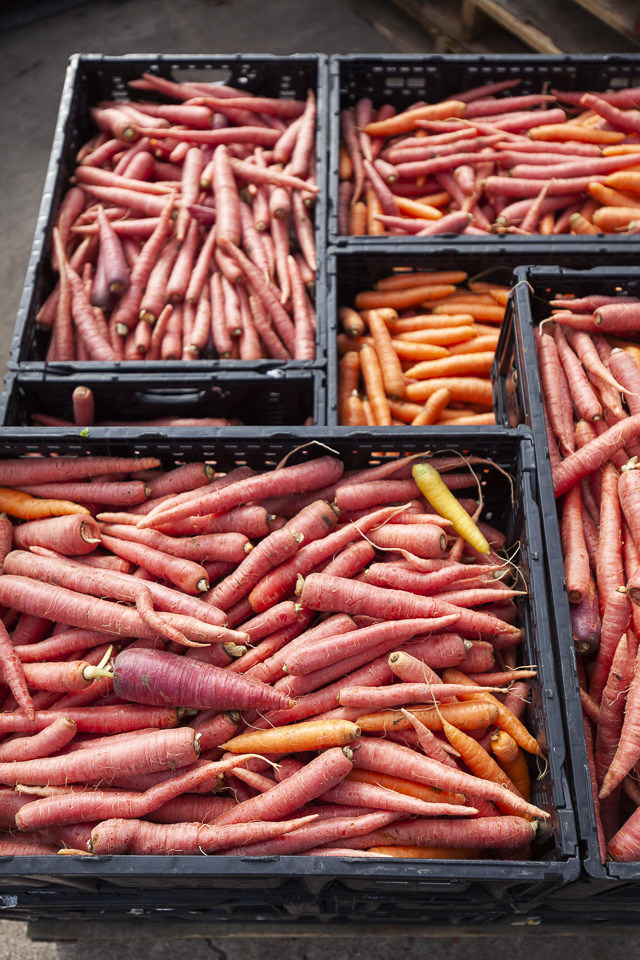 Carrots that make you want to go bunny. Photo by Scott David Gordon.
Carrots that make you want to go bunny. Photo by Scott David Gordon.
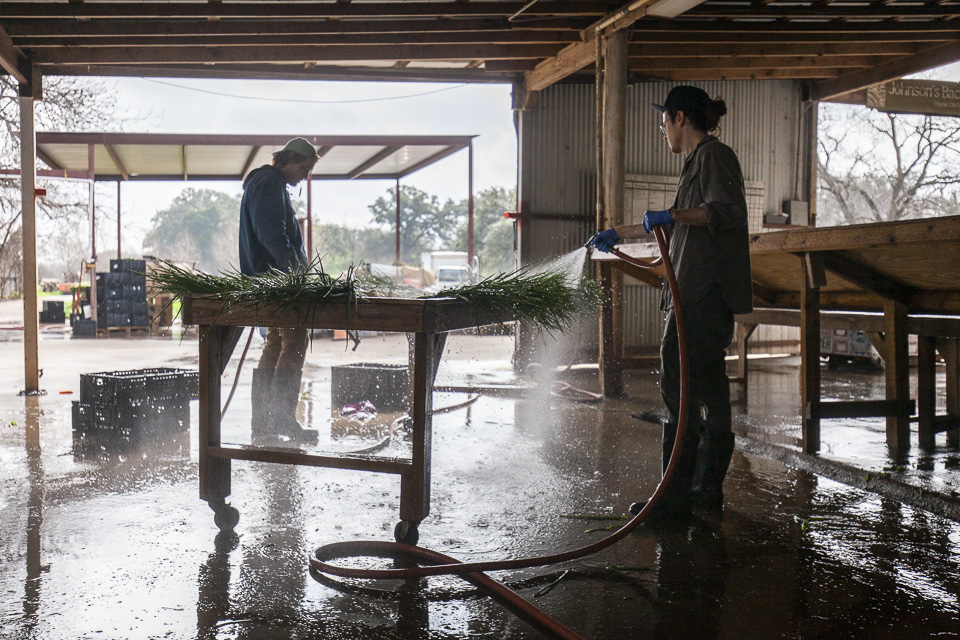 Cleaning up our green onions is wet work. Photo by Scott David Gordon.
Cleaning up our green onions is wet work. Photo by Scott David Gordon.
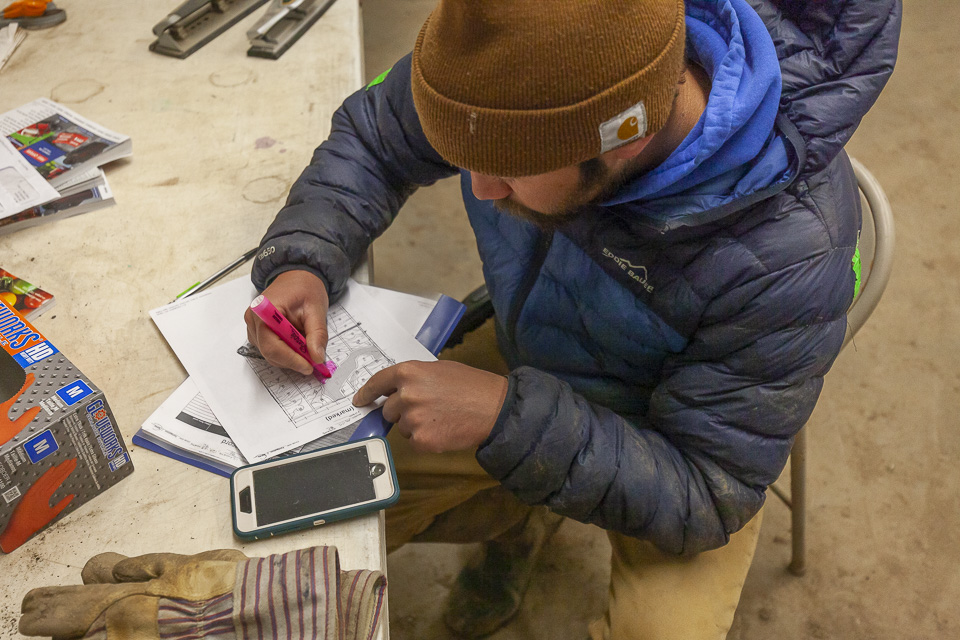 Luke calculating and documenting his fertigation plan for the onions. Photo by Scott David Gordon.
Luke calculating and documenting his fertigation plan for the onions. Photo by Scott David Gordon.
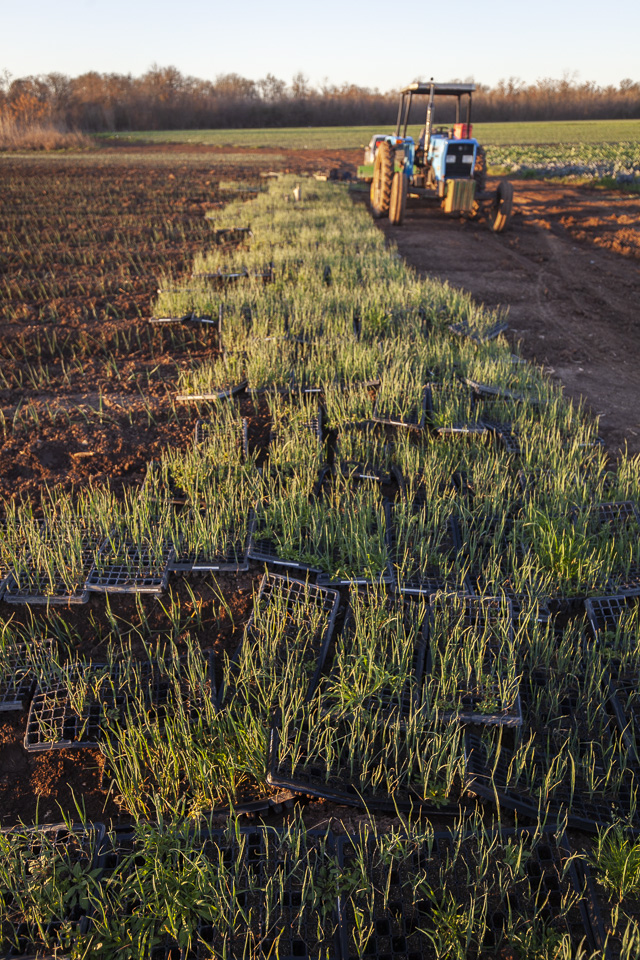 We still have a couple onions to plant.... Photo by Scott David Gordon.
We still have a couple onions to plant.... Photo by Scott David Gordon.
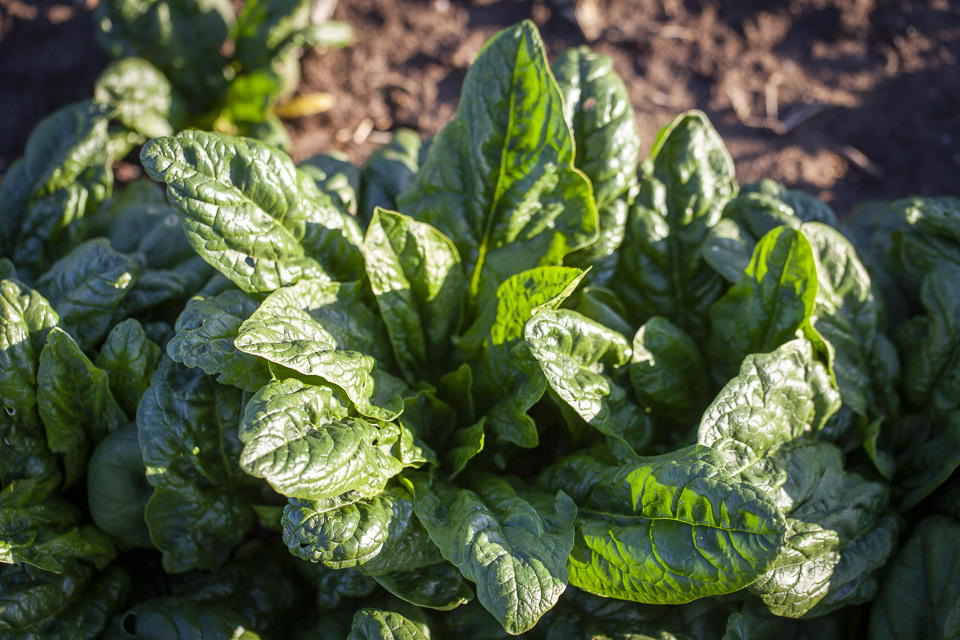 Spinach for the people. Photo by Scott David Gordon.
Spinach for the people. Photo by Scott David Gordon.
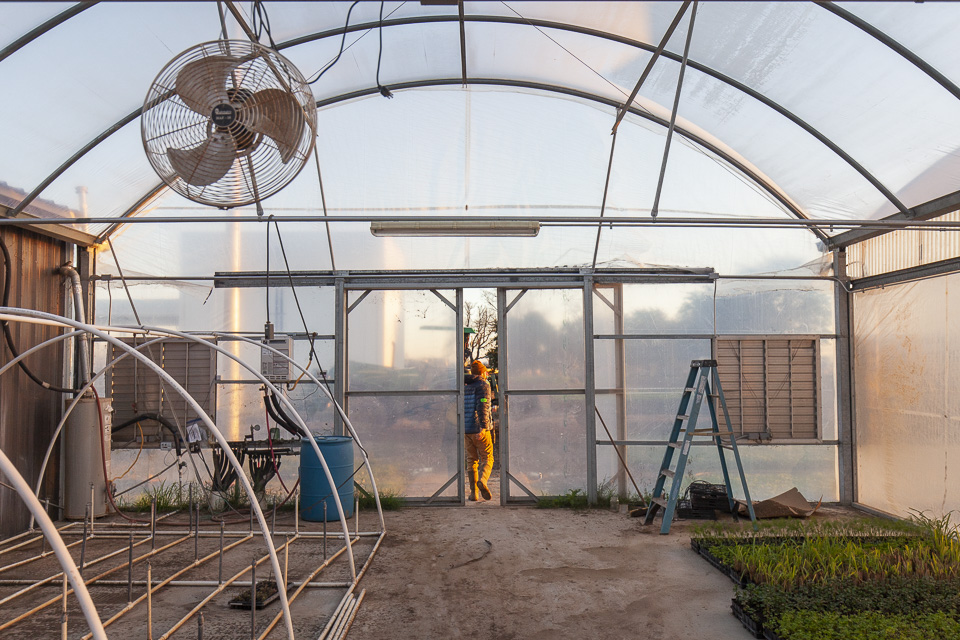 Greenhouse etiquette 101: Don't forget to close the door! Photo by Scott David Gordon.
Greenhouse etiquette 101: Don't forget to close the door! Photo by Scott David Gordon.
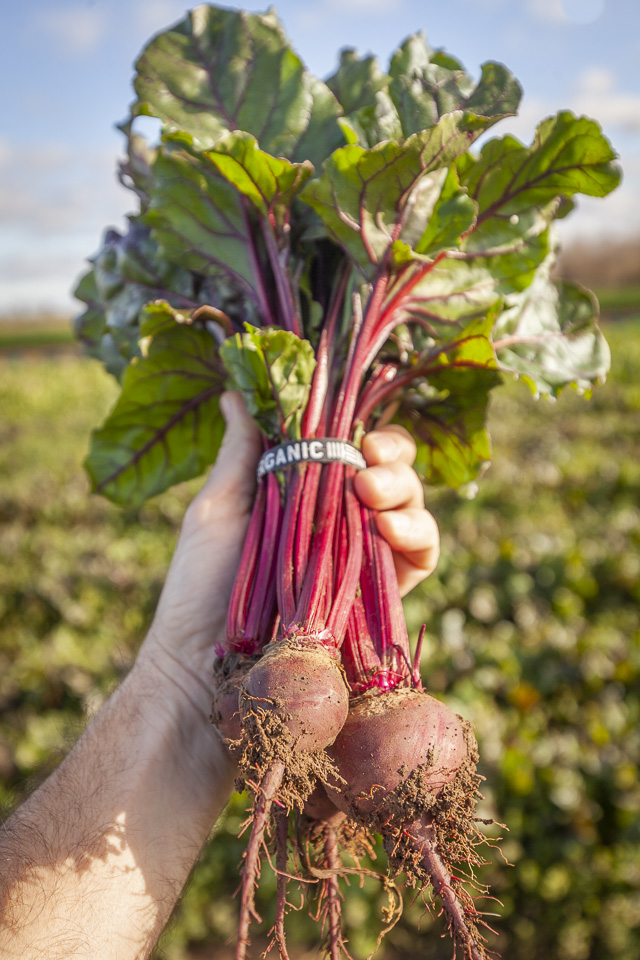 Welcome back, beets. It's great to see ya! Photo by Scott David Gordon.
Welcome back, beets. It's great to see ya! Photo by Scott David Gordon.FIELD UPDATE FROM BRENTON
01/31/20 — Ada Broussard
We sat down with Brenton this week and got the lowdown on happenings in the field. Per usual, there are a lot of happenings.
![]() Early morning manager meetings in the shelter of the greenhouse. Photo by Scott David Gordon.
Early morning manager meetings in the shelter of the greenhouse. Photo by Scott David Gordon.
Planting This is “go time” at the farm, and things are “really getting crazy”, according to Brenton. It goes without saying. All that beautiful spring bounty that you expect from farms? Well, that bounty is all being planted, now, and before it can be planted, it must be seeded, beds must be prepped, drip tape laid, and compost spread. Our greenhouse, as well as our hardening-off area outside the greenhouse, are full of transplants that need to be planted including fennel, leeks, kale, as well as brassicas like cabbage, broccoli, and cauliflower. Last week we got rained out on several days, so we’re a bit behind schedule with these transplants. We’re also trying to get our potatoes in the ground, which take about two weeks for their greens to poke out from the earth, and should be planted around two weeks before the average last frost. Which, believe it or not, is quickly approaching!
![]() Transplants hardening off outside our greenhouse, waiting for their turn to go into the ground. Photo by Scott David Gordon.
Transplants hardening off outside our greenhouse, waiting for their turn to go into the ground. Photo by Scott David Gordon.
In addition to trying to get our transplants and potatoes in the ground, we’re also beginning to gear up for another large round of direct seeded crops like beets and carrots. The weather hasn’t been perfect for direct seeding - the ground is a bit too damp in some areas of the farm and we’re having to be conservative… even though the ticking clock and a general sense of spring-fever has us wanting to plant, plant, plant.
Crops This has been a mild winter. Without pouring over data to confirm, we’ll go ahead and say that this definitely feels like the warmest and mildest winter we’ve had as a farm. Though our farm crews’ fingertips may benefit from this warmer weather, our cool-season crops haven’t had the same luck.
Case in point: beets. Which, are back! (Finally!) If you’re a CSA Member or market patron, you may have noticed the mysterious absence of beets in your JBG haul, a crop that usually defines our fall and winter season. We planted three large rounds of beets, begging in early fall, that all failed. Round one didn’t germinate properly due to the really hot weather that extended into the fall. Round two germinated beautifully! And then, came the hogs. They decimated our second planting of beets. Round three of beets was plagued by army worms, a pest that is usually deterred by the cold, but without any extreme cold, the worms prevailed. Unfortunately, this march of army worms hit at an extremely busy time in the fall (when we were busy fighting weeds), and we just didn’t have the staff to properly deal with the pests. Goodbye, round three. Lucky for us, the fourth time was a charm, and beets of all colors were harvested every day this week.
![]() Beets are finally here. Have you missed them like we have? Photo by Scott David Gordon.
Beets are finally here. Have you missed them like we have? Photo by Scott David Gordon.
Army worms aren’t the only pest that has thrived in this mild winter. The thrips, a pest that we usually expect to surface when the weather warms in late February, have made an extremely early appearance and are attaching themselves to our spring onion crop, their favorite feast. We’ll be fighting this generation of thrips hard, using neem oil and an extract from made from dried chrysanthemum flower heads called pyrethrum. Thrips, begone! Army worms, thrips, flea beetles… a lot of these bug populations usually get reduced by the cold weather, but with this mild winter we’re having, the bugs are here to test us.
![]() Look closely at this beautiful photo and you'll see tiny yellow bugs. These are thrips. If a few hitch a ride into your CSA box, don't worry: they're not dangerous and are merely annoying. Rinse them off, and continue on. Photo by Scott David Gordon.
Look closely at this beautiful photo and you'll see tiny yellow bugs. These are thrips. If a few hitch a ride into your CSA box, don't worry: they're not dangerous and are merely annoying. Rinse them off, and continue on. Photo by Scott David Gordon.
Equipment The one thing that tested us more than the bugs this week? Some of our equipment, specifically, our equipment that falls in the “antique” category. As we mentioned, it’s go-time for the direct seeing of our spring carrots and beets. This week, our beds were ready to go but surprisingly, our MaterMac seeder was not. Back when we first purchased this seeder, MaterMac was based in Italy, but has since then been sold to another company. Parts are hard to get, and even harder when you have a very old model, like ours. One MaterMac dealer is on the east coast, the other on the west coast, and after countless hours on the phone with each we learned that neither dealer had what we needed. In fact, we were originally told that the universal coupling we needed to make our seeder run “was obsolete, and did not exist”, which was a problem, because we needed not one of the couplings, but two.But, farmers aren’t really the giving-up type. We persisted, and learned that the west coast dealer had half of the assembly, and the east coast dealer had one whole assembly. With the parts that we still had at the farm, we were able to cobble together the other half, and after hours on the phone and two next-day air shipments, we were back in action.
![]() Jack, armed with a cell phone and spread sheets, scours the country for parts. Photo by Scott David Gordon.
Jack, armed with a cell phone and spread sheets, scours the country for parts. Photo by Scott David Gordon.
![]() Our Italian amico, the MaterMac. Photo by Scott David Gordon.
Our Italian amico, the MaterMac. Photo by Scott David Gordon.
This type of problem solving is typical… in fact, the seeder couplings weren’t the only parts we hunted for this week. The most geriatric tractor on our farm in our Case tractor, which is still the primary tractor we use for cultivation. It’s pretty common that we need to tinker with this sweet (but temperamental) tractor to get it started up, and this week whilst tinkering, we accidentally dropped a wrench in its depths and the radiator fan shattered.
Did we mention this tractor was old and special? We must have called 40 different places looking for a replacement radiator fan, but no one seemed to exist across the whole country. Finally, we found someone in Tennessee selling the identical, antique tractor. “All we need is the radiator fan. Can we buy that from you?” “Yep! For a hundred dollar bill!”. One Benjamin and another next-day air shipment later, and we were back in business.
![]() How could you ever be mad at this tractor? Photo by Scott David Gordon.
How could you ever be mad at this tractor? Photo by Scott David Gordon.
Looking Forward Tracy, one of our Hergotz managers, said it best this week, “There is so much positive momentum right now.” We are finishing harvesting some of our fall and winter plantings right now and are eager to get a fresh start this spring. Some of the crops you see right now might have a few tiny bug bites or might have edges that have been burned from an occasional freeze. We hope that these are friendly reminders that you’re eating organic produce, that is grown locally - produce that is unable to escape the realities of a particular weather season, and produce that also happens to be fresher and taste better than your average item from a grocery store.
The vegetables we grow may not always look perfect, especially at a moment like this, in between seasons and plantings when bugs are having a party, but this produce is not only nutritionally dense… it’s also delicious. When any degree of cold weather hits, our crops get busy converting some of their cells to a more sugary-version of themselves, yielding a sweeter and more delicious crop for you. Most of our crops are harvested one day, and delivered the next. They’re fresh as all get-up. If you’re new to eating local produce, it might take some time to shake the perfect standards that grocery stores have reinforced. These same standards, unfortunately, have been the cause of a vast amount of waste in our food system. To be clear, we don't want to have produce that ever looks damaged, but perfect produce comes at a financial cost to farms: it costs more fuel to drive over fields, to do another pest spray, all the while harming beneficial insects in the process.
We strive to strike a balance here, and we hope our update from the fields this week demonstrates all the figuring and phone calls that goes into creating that balance. Thanks for reading, and as always, thanks for supporting the farm.
![]() "What do you mean the seeder is broken?" Photo by Scott David Gordon.
"What do you mean the seeder is broken?" Photo by Scott David Gordon.
P.S. Speaking of positive momentum, are you planting a spring garden this year? If you’ve made it to the bottom of this post, you’ll be the first to know a little secret: Our Spring Transplant Sale is going live next week! Keep your eyes peeled!
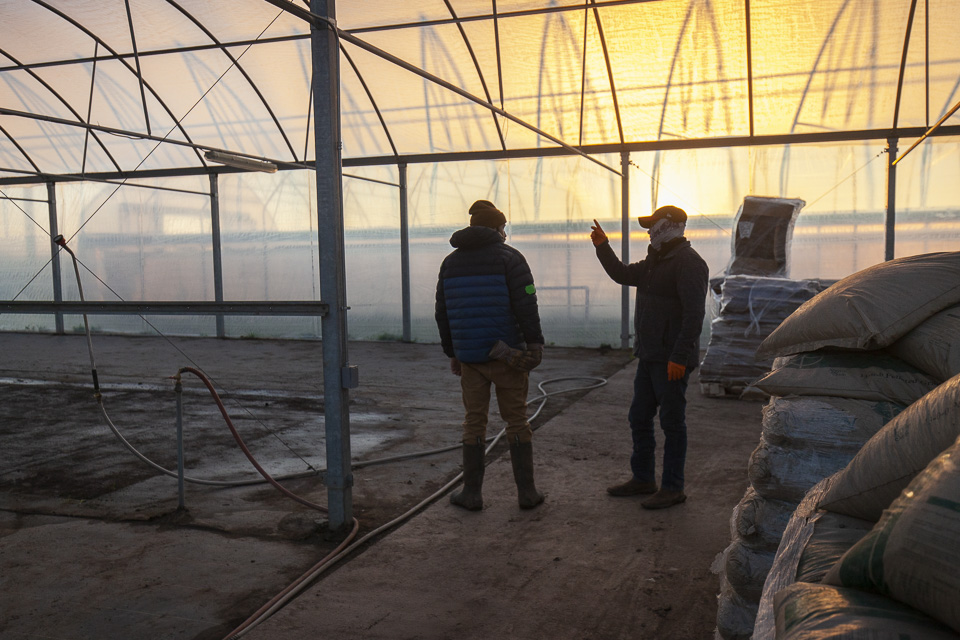 Early morning manager meetings in the shelter of the greenhouse. Photo by Scott David Gordon.
Early morning manager meetings in the shelter of the greenhouse. Photo by Scott David Gordon.
Planting This is “go time” at the farm, and things are “really getting crazy”, according to Brenton. It goes without saying. All that beautiful spring bounty that you expect from farms? Well, that bounty is all being planted, now, and before it can be planted, it must be seeded, beds must be prepped, drip tape laid, and compost spread. Our greenhouse, as well as our hardening-off area outside the greenhouse, are full of transplants that need to be planted including fennel, leeks, kale, as well as brassicas like cabbage, broccoli, and cauliflower. Last week we got rained out on several days, so we’re a bit behind schedule with these transplants. We’re also trying to get our potatoes in the ground, which take about two weeks for their greens to poke out from the earth, and should be planted around two weeks before the average last frost. Which, believe it or not, is quickly approaching!
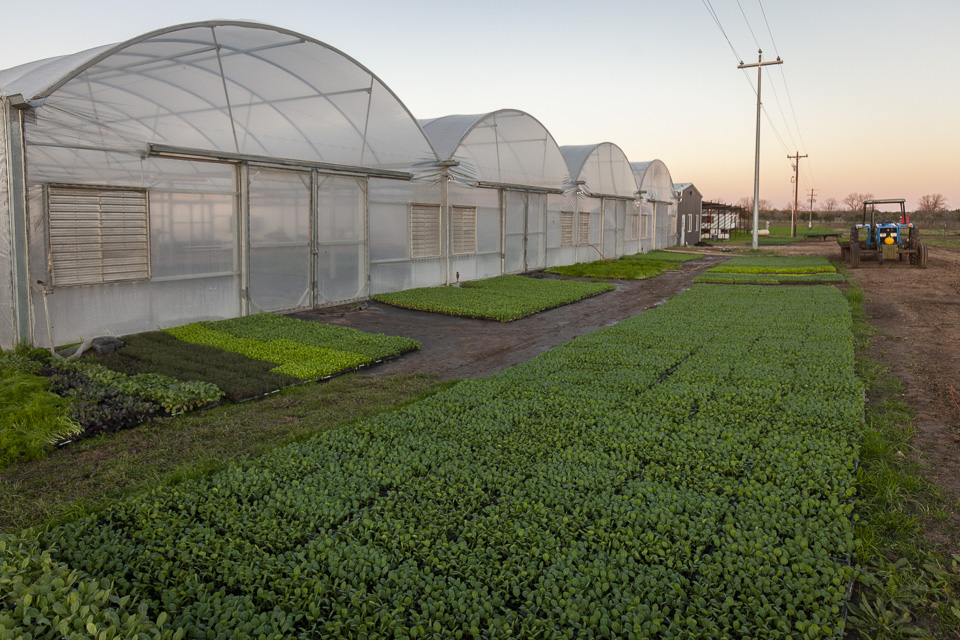 Transplants hardening off outside our greenhouse, waiting for their turn to go into the ground. Photo by Scott David Gordon.
Transplants hardening off outside our greenhouse, waiting for their turn to go into the ground. Photo by Scott David Gordon.
In addition to trying to get our transplants and potatoes in the ground, we’re also beginning to gear up for another large round of direct seeded crops like beets and carrots. The weather hasn’t been perfect for direct seeding - the ground is a bit too damp in some areas of the farm and we’re having to be conservative… even though the ticking clock and a general sense of spring-fever has us wanting to plant, plant, plant.
Crops This has been a mild winter. Without pouring over data to confirm, we’ll go ahead and say that this definitely feels like the warmest and mildest winter we’ve had as a farm. Though our farm crews’ fingertips may benefit from this warmer weather, our cool-season crops haven’t had the same luck.
Case in point: beets. Which, are back! (Finally!) If you’re a CSA Member or market patron, you may have noticed the mysterious absence of beets in your JBG haul, a crop that usually defines our fall and winter season. We planted three large rounds of beets, begging in early fall, that all failed. Round one didn’t germinate properly due to the really hot weather that extended into the fall. Round two germinated beautifully! And then, came the hogs. They decimated our second planting of beets. Round three of beets was plagued by army worms, a pest that is usually deterred by the cold, but without any extreme cold, the worms prevailed. Unfortunately, this march of army worms hit at an extremely busy time in the fall (when we were busy fighting weeds), and we just didn’t have the staff to properly deal with the pests. Goodbye, round three. Lucky for us, the fourth time was a charm, and beets of all colors were harvested every day this week.
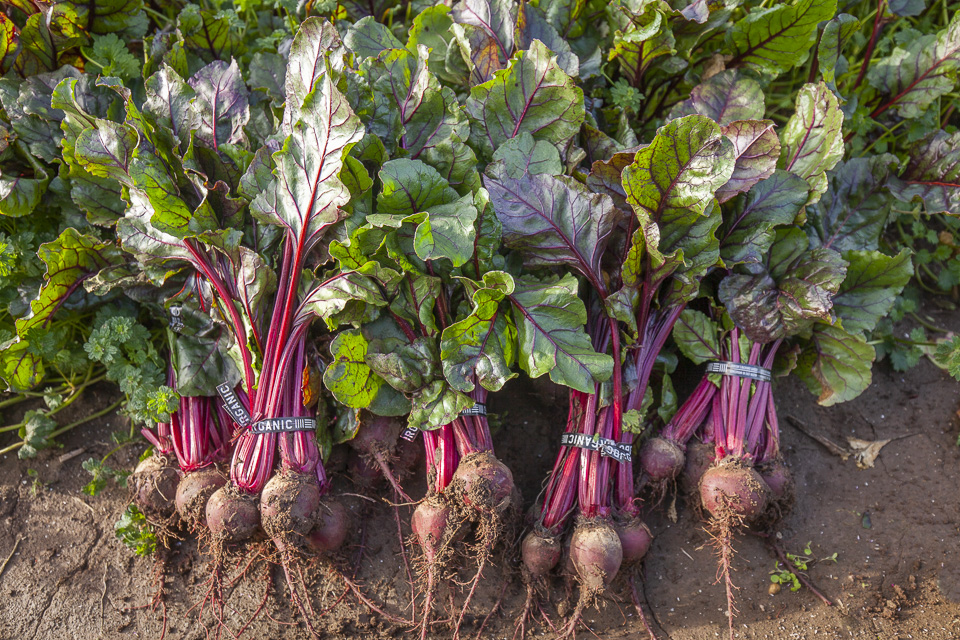 Beets are finally here. Have you missed them like we have? Photo by Scott David Gordon.
Beets are finally here. Have you missed them like we have? Photo by Scott David Gordon.
Army worms aren’t the only pest that has thrived in this mild winter. The thrips, a pest that we usually expect to surface when the weather warms in late February, have made an extremely early appearance and are attaching themselves to our spring onion crop, their favorite feast. We’ll be fighting this generation of thrips hard, using neem oil and an extract from made from dried chrysanthemum flower heads called pyrethrum. Thrips, begone! Army worms, thrips, flea beetles… a lot of these bug populations usually get reduced by the cold weather, but with this mild winter we’re having, the bugs are here to test us.
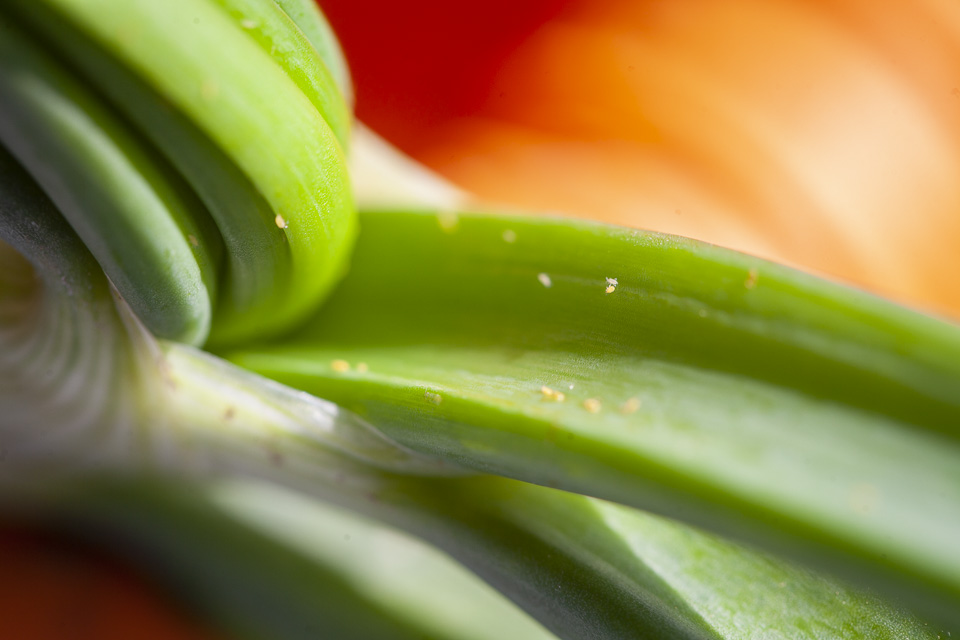 Look closely at this beautiful photo and you'll see tiny yellow bugs. These are thrips. If a few hitch a ride into your CSA box, don't worry: they're not dangerous and are merely annoying. Rinse them off, and continue on. Photo by Scott David Gordon.
Look closely at this beautiful photo and you'll see tiny yellow bugs. These are thrips. If a few hitch a ride into your CSA box, don't worry: they're not dangerous and are merely annoying. Rinse them off, and continue on. Photo by Scott David Gordon.
Equipment The one thing that tested us more than the bugs this week? Some of our equipment, specifically, our equipment that falls in the “antique” category. As we mentioned, it’s go-time for the direct seeing of our spring carrots and beets. This week, our beds were ready to go but surprisingly, our MaterMac seeder was not. Back when we first purchased this seeder, MaterMac was based in Italy, but has since then been sold to another company. Parts are hard to get, and even harder when you have a very old model, like ours. One MaterMac dealer is on the east coast, the other on the west coast, and after countless hours on the phone with each we learned that neither dealer had what we needed. In fact, we were originally told that the universal coupling we needed to make our seeder run “was obsolete, and did not exist”, which was a problem, because we needed not one of the couplings, but two.But, farmers aren’t really the giving-up type. We persisted, and learned that the west coast dealer had half of the assembly, and the east coast dealer had one whole assembly. With the parts that we still had at the farm, we were able to cobble together the other half, and after hours on the phone and two next-day air shipments, we were back in action.
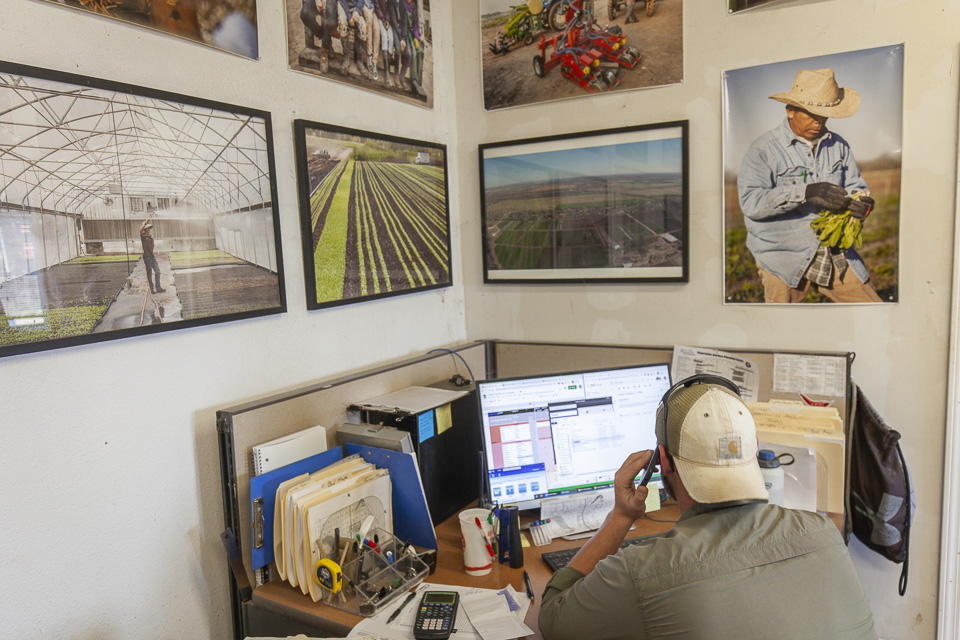 Jack, armed with a cell phone and spread sheets, scours the country for parts. Photo by Scott David Gordon.
Jack, armed with a cell phone and spread sheets, scours the country for parts. Photo by Scott David Gordon.
 Our Italian amico, the MaterMac. Photo by Scott David Gordon.
Our Italian amico, the MaterMac. Photo by Scott David Gordon.
This type of problem solving is typical… in fact, the seeder couplings weren’t the only parts we hunted for this week. The most geriatric tractor on our farm in our Case tractor, which is still the primary tractor we use for cultivation. It’s pretty common that we need to tinker with this sweet (but temperamental) tractor to get it started up, and this week whilst tinkering, we accidentally dropped a wrench in its depths and the radiator fan shattered.
Did we mention this tractor was old and special? We must have called 40 different places looking for a replacement radiator fan, but no one seemed to exist across the whole country. Finally, we found someone in Tennessee selling the identical, antique tractor. “All we need is the radiator fan. Can we buy that from you?” “Yep! For a hundred dollar bill!”. One Benjamin and another next-day air shipment later, and we were back in business.
 How could you ever be mad at this tractor? Photo by Scott David Gordon.
How could you ever be mad at this tractor? Photo by Scott David Gordon.
Looking Forward Tracy, one of our Hergotz managers, said it best this week, “There is so much positive momentum right now.” We are finishing harvesting some of our fall and winter plantings right now and are eager to get a fresh start this spring. Some of the crops you see right now might have a few tiny bug bites or might have edges that have been burned from an occasional freeze. We hope that these are friendly reminders that you’re eating organic produce, that is grown locally - produce that is unable to escape the realities of a particular weather season, and produce that also happens to be fresher and taste better than your average item from a grocery store.
The vegetables we grow may not always look perfect, especially at a moment like this, in between seasons and plantings when bugs are having a party, but this produce is not only nutritionally dense… it’s also delicious. When any degree of cold weather hits, our crops get busy converting some of their cells to a more sugary-version of themselves, yielding a sweeter and more delicious crop for you. Most of our crops are harvested one day, and delivered the next. They’re fresh as all get-up. If you’re new to eating local produce, it might take some time to shake the perfect standards that grocery stores have reinforced. These same standards, unfortunately, have been the cause of a vast amount of waste in our food system. To be clear, we don't want to have produce that ever looks damaged, but perfect produce comes at a financial cost to farms: it costs more fuel to drive over fields, to do another pest spray, all the while harming beneficial insects in the process.
We strive to strike a balance here, and we hope our update from the fields this week demonstrates all the figuring and phone calls that goes into creating that balance. Thanks for reading, and as always, thanks for supporting the farm.
 "What do you mean the seeder is broken?" Photo by Scott David Gordon.
"What do you mean the seeder is broken?" Photo by Scott David Gordon.
P.S. Speaking of positive momentum, are you planting a spring garden this year? If you’ve made it to the bottom of this post, you’ll be the first to know a little secret: Our Spring Transplant Sale is going live next week! Keep your eyes peeled!
FRENCH GRATED CARROT SALAD
01/30/20 — Ada Broussard
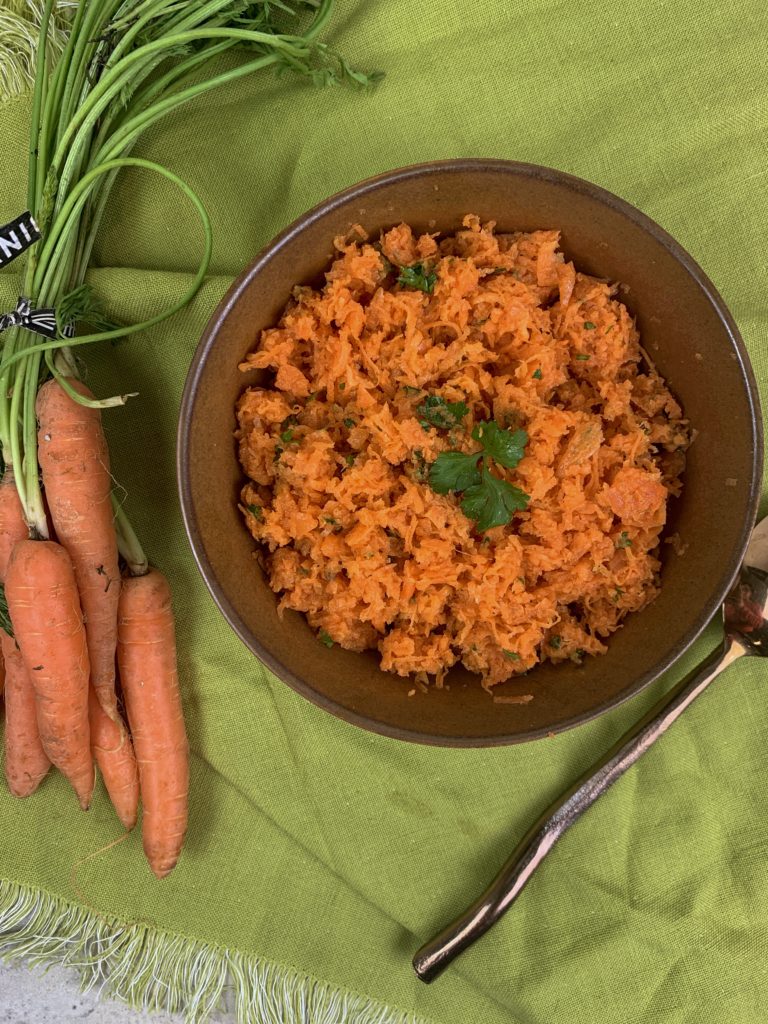 French Grated Carrot Salad
French Grated Carrot Salad
Servings: 2-4 Total Time: 15 minutes Author: The Migoni Kitchen
This is such a common salad all over France. I grew up eating it every summer visiting my grandparents. It’s so incredibly simple and great way to highlight carrots. A great picnic salad or to pair with any protein. We use a food processor to grate the carrots, but a box grated can also be used.
Ingredients:
- 1 lb carrots, grated finely
- 2 tbsp white vinegar or apple cider vinegar
- 2 tbsp olive oil
- 1/2 tsp lemon juice
- 1/4 tsp black pepper
- 1/2 tsp Kosher salt
- 1 tbsp fresh parsley
CSA BOX CONTENTS WEEK OF JAN 27TH
01/28/20 — Scott
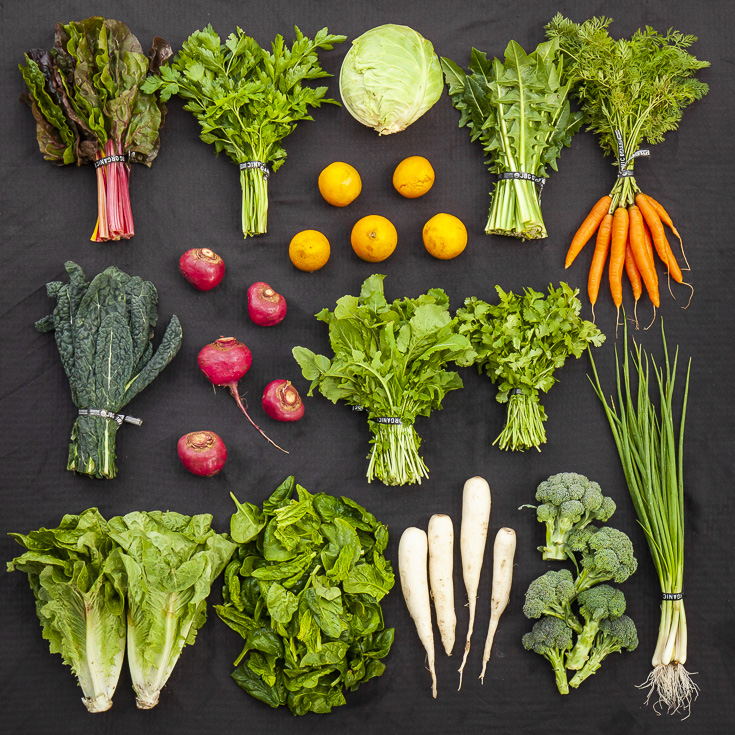 CSA Box Contents Week of Jan 27th
CSA Box Contents Week of Jan 27th
Large Box
Beets
Broccoli
Cabbage
Carrot, Orange
Cauliflower
Greens, Kale, Curly
Greens, Mustard
Greens, Spinach
Herb, Cilantro
Lettuce, Romaine
Onion, Spring White
Radish, French Breakfast
Beets
Broccoli
Cabbage
Carrot, Orange
Cauliflower
Greens, Kale, Curly
Greens, Mustard
Greens, Spinach
Herb, Cilantro
Lettuce, Romaine
Onion, Spring White
Radish, French Breakfast
Medium Box
Beets
Broccoli
Cabbage
Carrot, Orange
Greens, Kale, Curly
Greens, Mustard
Herb, Parsley, Flat
Lettuce, Romaine
Onion, Multiplying
Turnip, White Japanese
Beets
Broccoli
Cabbage
Carrot, Orange
Greens, Kale, Curly
Greens, Mustard
Herb, Parsley, Flat
Lettuce, Romaine
Onion, Multiplying
Turnip, White Japanese
Small Box
Broccoli
Carrot, Orange
Cauliflower
Greens, Chard, Rainbow
Greens, Kale, Curly
Herb, Cilantro
Onion, Spring White
Broccoli
Carrot, Orange
Cauliflower
Greens, Chard, Rainbow
Greens, Kale, Curly
Herb, Cilantro
Onion, Spring White
Individual Box
Beets
Broccoli
Carrot, Orange
Cauliflower
Greens, Chard, Rainbow
Onion, Spring White
Beets
Broccoli
Carrot, Orange
Cauliflower
Greens, Chard, Rainbow
Onion, Spring White






 0 ITEMS IN CART
0 ITEMS IN CART 

